We Tested 9 Sauté Pans, and 3 (Shallow) Fried The Competition
Dotdash Meredith and Yahoo Inc. may earn commission or revenue on some items through the links below.
Our top picks come from Made In, All-Clad, and Misen.
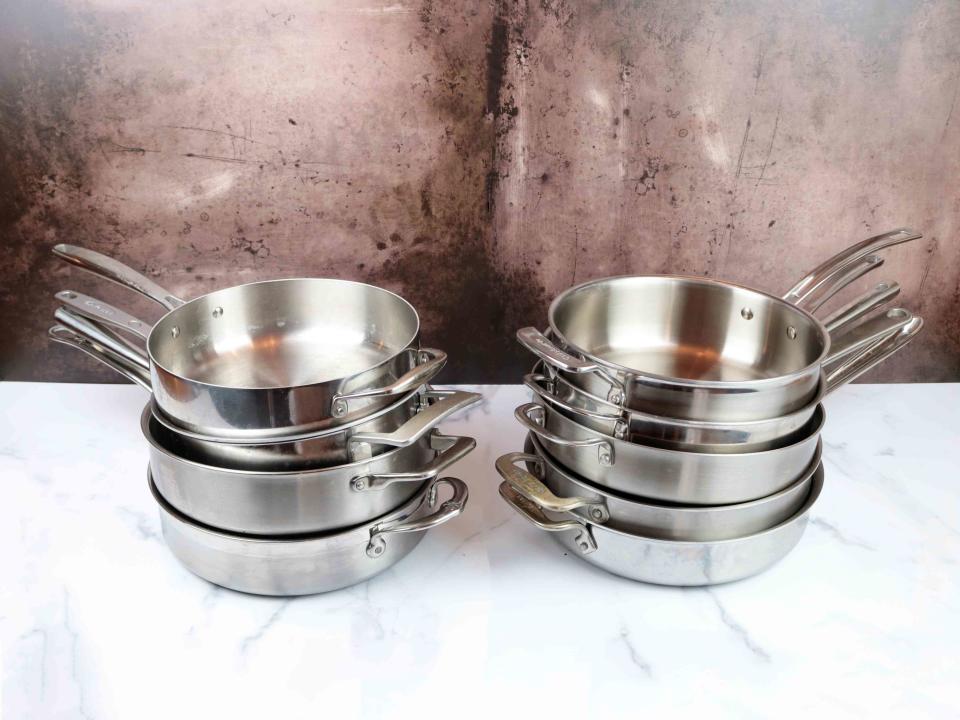
Serious Eats / Jesse Raub
Our favorite sauté pan is the Made In Stainless Clad 3.5-Qt. Saute Pan for its even heating, comfortable handles, and responsiveness. We also really liked the All-Clad D3 3-Qt.Stainless Steel Saute Pan (thought it’s a little pricier), and the Misen 3-Qt. Saute Pan was a great budget pick.
When building out your cookware collection, it’s important to snag a skillet for searing and a Dutch oven for stewing, boiling, and deep frying. Somewhere in between the two, however, is the sauté pan. With a wide cooking surface and low, straight sides, it’s ideal for shallow frying meatballs or falafel, braising bone-in chicken pieces, and wilting large quantities of greens. Sauté pans have an aluminum core clad in stainless steel, making them quick to heat, responsive to temperature changes, and highly durable.
Compared to a skillet, sauté pans have a much larger volume (every pan we tested held 3 to 3.5 quarts). One question remains, though: which one is the best? To find out, we put nine sauté pans through a number of tests to see which one could shallow fry, sear, braise, and wilt better than the rest.
The Winners, at a Glance
The Best Overall Sauté Pan: Made In Stainless Clad Saute Pan 3.5 QT

With a comfortable, ergonomic handle, moderate weight, and wide cooking surface, the Made In Stainless Clad Sauté Pan aced our cooking tests and was easy to handle and clean up. Ultimately, it won our top pick for its excellent performance and reasonable price.
Also Great: All-Clad D3 Tri-Ply 3-Quart Stainless Steel Sauté Pan
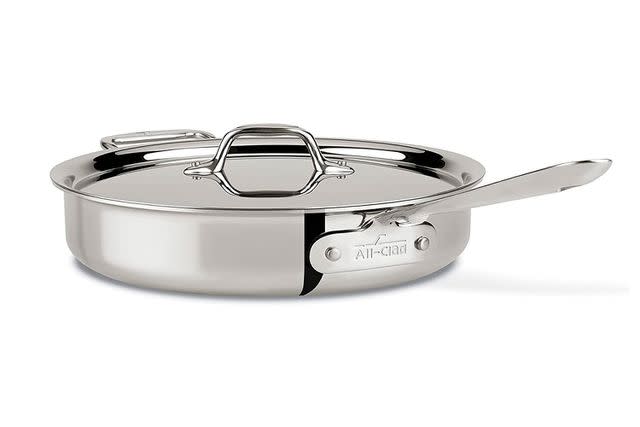
Featuring the widest cooking surface of all the pans we tested, we also really loved the All-Clad D3 Sauté Pan. It heated evenly and quickly, and the extra-long handle helped balance its weight. It was one of our favorite pans to cook with but was also one of the priciest.
The Best Budget Sauté Pan: Misen 3-Qt. Sauté Pan

Even though it was the heaviest pan, the Misen Sauté Pan was surprisingly responsive to temperature changes. It seared, braised, and shallow fried nearly as well as our top picks, and its lower price makes it a good value.
The Tests
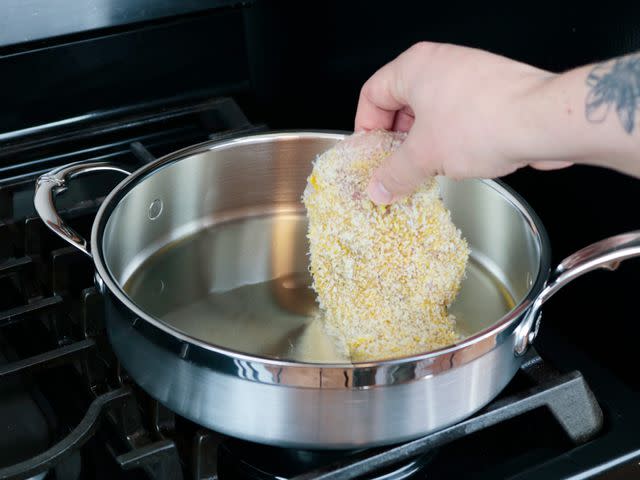
Serious Eats / Jesse Raub
Braising Test: We made braised chicken thighs to look how each pan browned and braised, and to evaluate how comfortable each pan was to move from the stovetop to the oven.
Shallow Frying Test: We made chicken piccata to test each pan’s ability to shallow fry and build a sauce, and how easy it was to pour off excess oil and clean the pan up afterwards.
Even Heating Test: We heated each pan empty with the burner set to medium and used an infrared thermometer to check for hot spots.
Spinach Wilting Test (Winners-Only): We tested the capacity of the best performing pans by wilting a pound of spinach in each one.
Cleanup and Usability Tests: We washed each pan by hand after every test and ran them through the dishwasher at the end of testing. We also looked into handle comfort, weight balance, lid fit, and other usability and design details. We even banged them together to test their durability.
What We Learned
Most Pans Performed Well
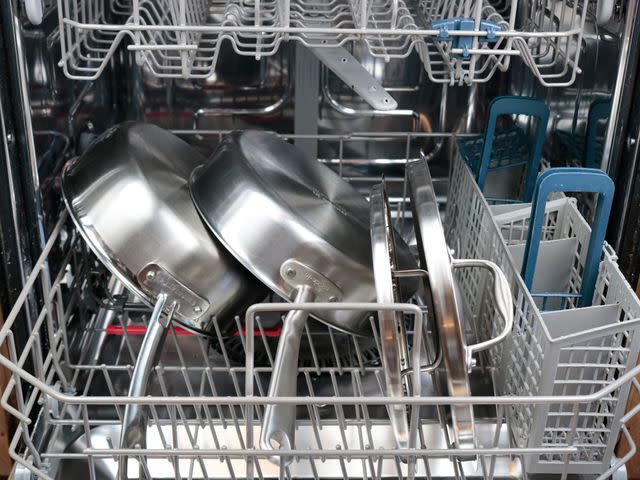
Serious Eats / Jesse Raub
Every pan held up in the dishwasher and was easy to clean by hand, too.When it came to cooking, every pan we tested was able to execute both recipes well, showing off the strengths of a sauté pan. While some pans browned quicker than others, the differences weren’t extreme, and slight tweaks to a recipe’s cook time (or your burner) could likely accommodate whatever pan you use. They were all really easy to clean, held up to durability tests, and made it through the dishwasher unscathed. It was each pan’s usability that determined the winners: details like cooking surface area, side height, handle shape, and lid fit not only boosted the performance of our winners (if only slightly), but also made them more versatile and easier to use.
Wider Cooking Surfaces Were More Important than Overall Capacity
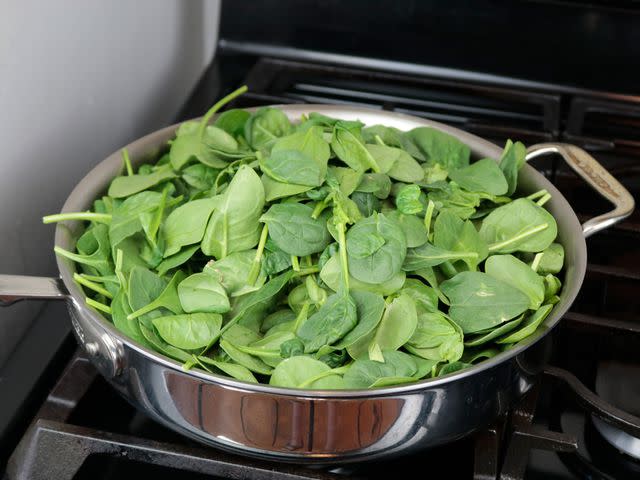
Serious Eats / Jesse Raub
The All-Clad pan had the widest cooking surface and could easily accommodate a full clamshell of spinach.Browning requires space between food for moisture to evaporate, and a crowded pan will inhibit this. Our favorite pans from Made In, All-Clad, and Misen (and the one from Hestan, too) all had near 10-inch cooking surfaces, allowing chicken thighs plenty of room to brown and cutlets to fry. Taller and narrower pans—even if they had a larger overall capacity—crowded food while cooking. The model from Cuisinart had just 8.5 inches of usable cooking space, so chicken thighs didn’t brown and braised cabbage didn’t break down as well.
Read More:We Tested 29 Stainless-Steel Skillets to Find the Best Ones
Even Heat Distribution Meant Even Browning
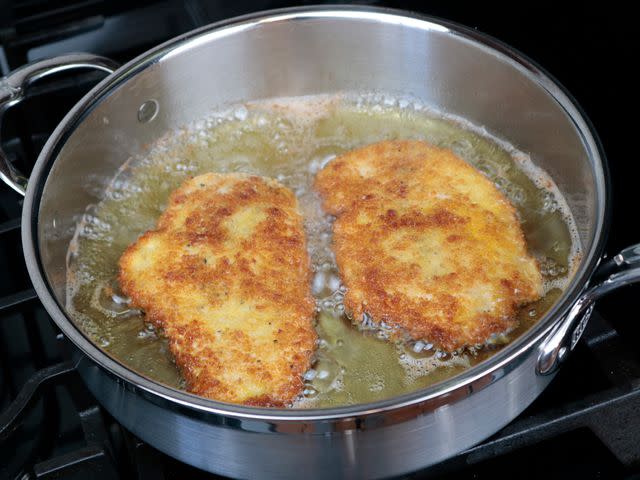
Serious Eats / Jesse Raub
The Hestan pan (shown here) browned the chicken evenly, but took longer than other pans thanks to added material mass.We used an infrared thermometer to see how evenly the pans' surfaces heated up, and thinner pans (like the Calphalon and Tramontina models) had centers that read 20 to 30 degrees hotter than the edges. When it came to frying, these pans were quick to singe parts of the chicken cutlets' breading while leaving other sections pale. Thicker pans, like the ones from Hestan and Demeyere, had cooking surfaces that varied only by a few degrees—but they also heated much more slowly. While the cutlets and thighs both technically browned evenly in these pans, they were also still quite pale when the recipe’s cook time said to flip.
Heavier Pans Were Ideal for Browning and Braising
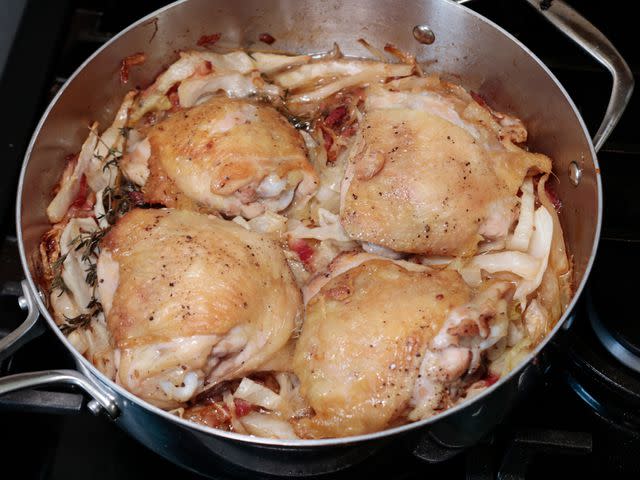
Serious Eats / Jesse Raub
Thinner pans (like the one shown here) struggled to brown chicken thighs as well as the thicker models.The best performance came from moderate weight pans (clocking it at about three pounds without a lid), which were able to heat up relatively quickly and evenly, and maintained their temperature fairly well when food was added. The oil temperature only dropped 20ºF before leveling out in the All-Clad, Made In, and Misen pans, producing perfectly golden brown cutlets. Thinner pans sometimes dropped 30 to 40 degrees. The weightiness of these pans also kept chicken thigh temps at a consistent 180ºF during the last 15 minutes of braising, whereas thighs braised in thinner pans skyrocketed to a 195ºF internal temperature after just 25 to 30 minutes in the oven.
Handle Shape and Angle Were Key for Comfort
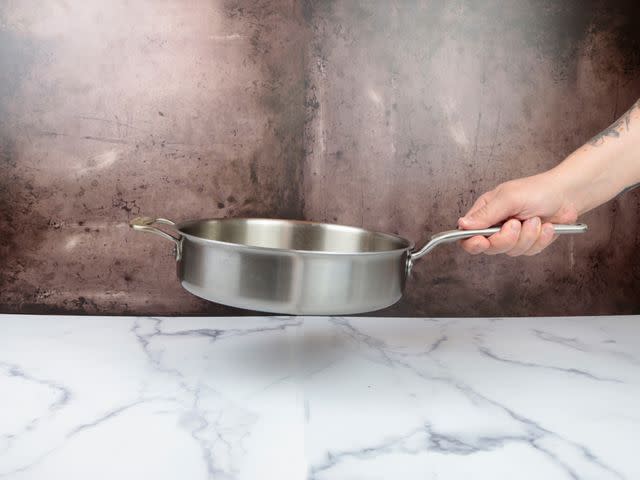
Serious Eats / Jesse Raub
The slightly offset handle of the Made In pan was comfortable to grasp and made it easy to hold the pan level.The most comfortable handles were rounded, had grooves for your thumb, and were set at upward, ergonomic angles that balanced the weight of the pans. We liked how the fuller handle of the Hestan gave our thumb a place to rest, but the handle wasn’t offset enough to counter the weight of the pan and it required two hands to pick up. In contrast, the Made In handle had a flat surface that our thumb could securely rest on, while the angle of the handle let us keep our wrist straight when picking the pan up one-handed. We also liked the extra-long All-Clad handle. The length helped balance the weight of the pan, and it was the easiest pan to move from the stove to the oven.
The Criteria: What to Look for in a Sauté Pan
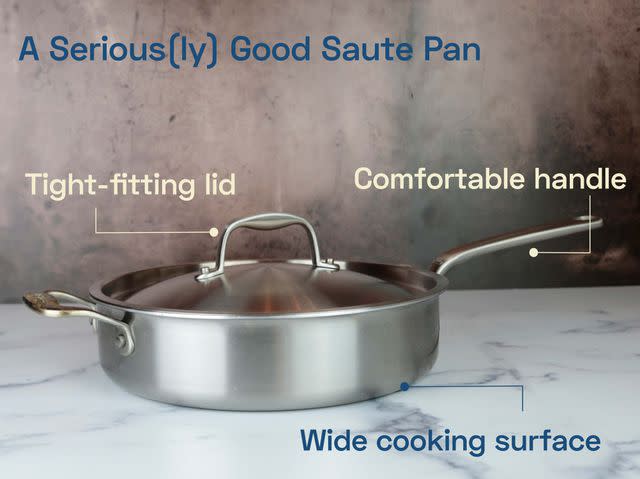
Serious Eats / Jesse Raub
The best sauté pans heat evenly, are responsive to temperature changes, and have a wide cooking surface that can accommodate larger recipes. They also have comfortable and well-balanced handles, tight-fitting lids, and are durable and easy to clean.
The Best Overall Sauté Pan: Made In Stainless Clad Saute Pan 3.5 QT

What we liked: In short: we liked pretty much everything about this pan. It crisped chicken skin evenly, browned cutlets with aplomb, and braised cabbage until it was silky and lightly caramelized. The wide cooking surface had plenty of space to accommodate larger recipes, the flared lip made it easy to pour off excess cooking oil, and the tight-fitting lid had a high dome, which made it easy to cram a huge mound of spinach into the pan and still have the lid seal. The handle was rounded enough to fit into our palm nicely while still having a flat surface for our thumb, and the angles of both the handle and the secondary helper handle were ergonomic and kept our wrists straight. To top it all off, it has an incredible max heat rating of 800ºF; 200ºF hotter than any of the competition. It’s doubtful you’d ever need it to be that high, but it speaks to the overall durability of this pan.
What we didn’t like: The biggest downside is the price: sauté pans have a lot more material than a skillet, and stainless steel-clad aluminum doesn’t come cheap. We still think this pan is valued well and should last you a lifetime, but it’s an investment.
Price at time of publish: $149.
Key Specs
Weight: 3 lbs; 4 lbs with lid
Materials: Stainless steel, aluminum, aluminum alloy
Overall dimensions: 21 x 11 x 2.75 inches
Cooking surface diameter: 9.75 inches
Handle length: 8.5 inches
Construction: 5-ply
Maximum temperature: 800ºF
Induction-friendly: Yes
Capacity: 3.5 quarts
Care instructions: Dishwasher-safe; hand-washing recommended
Warranty: Limited-lifetime warranty
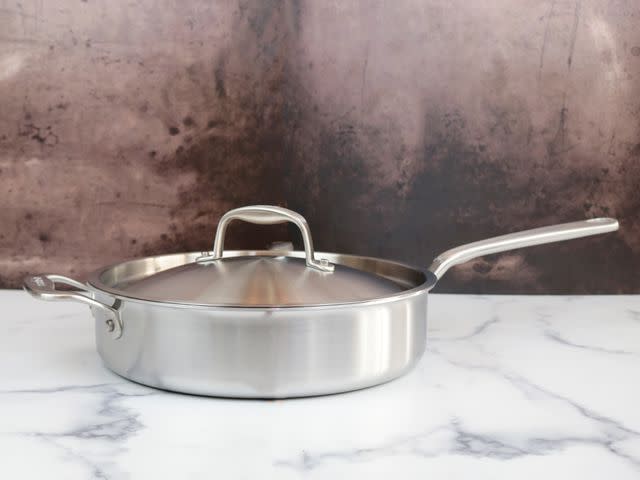
Serious Eats / Jesse Raub
Also Great: All-Clad D3 Tri-Ply 3-Quart Stainless Steel Sauté Pan

What we liked: The All-Clad sauté pan had the widest cooking surface out of any of the pans we tested, and the most consistent browning in both chicken recipes as well. It was also quick to cool down when it was time to build the piccata sauce after the cutlets were fried, ensuring no scorching. The extra-long handle helped balance the weight of the pan when moving it from the stovetop to the oven, and the cabbage braised beautifully. All-Clad has been making stainless steel clad aluminum core pans for decades now, and it shows.
What we didn’t like: While this pan had the widest cooking surface, it also had the shallowest sides. While that was great for searing, it meant more oil splatter on the stove during frying. And while some might really like All-Clad’s aggressively angled handles, they can be tough for shorter people to get a hold of (as noted in our skillet review). Lastly: the price. Performance-wise the All-Clad pan may have just slightly edged out the Made In model, but it'll cost you $30 more.
Price at time of publish: $180.
Key Specs
Weight: 3.3 lbs; 4.5 lbs with lid
Materials: Stainless steel, aluminum
Overall dimensions: 21.5 x 11.5 x 2.5 inches
Cooking surface diameter: 10 inches
Handle length: 9 inches
Construction: 3-ply
Maximum temperature: 600ºF
Induction-friendly: Yes
Capacity: 3 quarts
Care instructions: Dishwasher-safe; hand-washing recommended
Warranty: Limited lifetime warranty
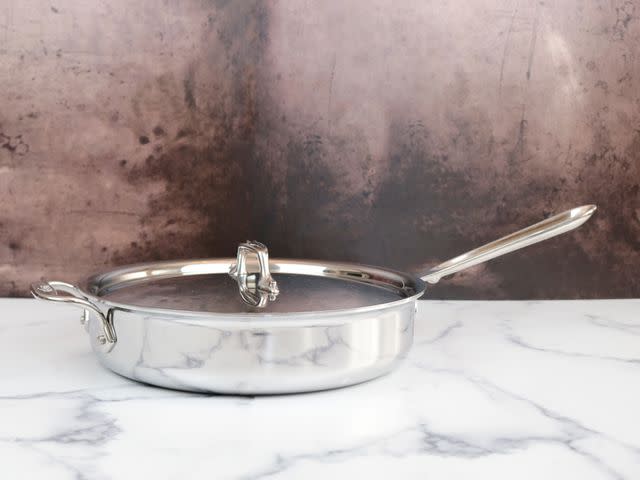
Serious Eats / Jesse Raub
The Best Budget Sauté Pan: Misen 3-Qt. Sauté Pan

What we liked: Even though it was the heaviest pan we tested, this model from Misen was actually quite responsive to temperature changes. We really liked how stable it held the oil temperature during frying, and that it was still responsive enough to cool down for the piccata sauce. The rounded handle was comfortable to hold, and it browned and braised nearly as well as our winners—and it’s 30% cheaper, too. If you don’t need top performance, it’s a great pan that’ll serve most people well.
What we didn’t like: There was some uneven browning on the chicken thighs, and the bacon lardons began to crisp up before they were fully rendered. Both of these issues were easily solved by adjusting the burner, but we also wish the handle had a more aggressive angle to help balance the pan’s extra weight.
Price at time of publish: $105.
Key Specs
Weight: 3.8 lbs; 5.1 lbs with lid
Materials: Stainless steel, aluminum
Overall dimensions: 21 x 11 x 3 inches
Cooking surface diameter: 9.75 inches
Handle length: 8 inches
Construction: 5-ply
Maximum temperature: 500ºF
Induction-friendly: Yes
Capacity: 3 quarts
Care instructions: Dishwasher-safe; hand-washing recommended
Warranty: Lifetime guarantee
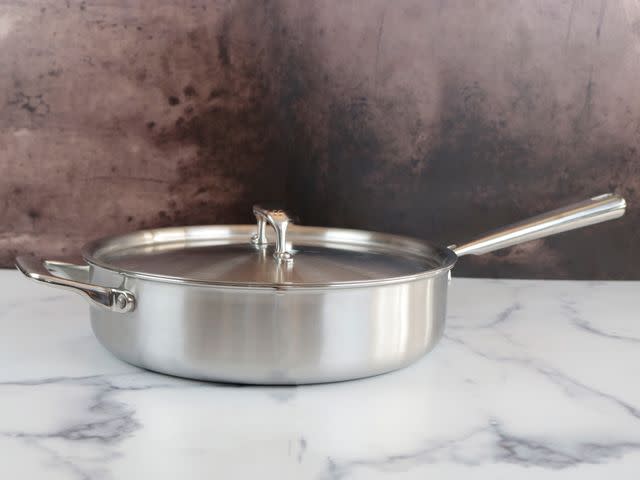
Serious Eats / Jesse Raub
The Competition
Tramontina 3-Qt. Stainless Steel Saute Pan: With a narrow cooking surface, the chicken cutlets and thighs were crowded in this pan. The pan was also thin, which caused food to brown unevenly.
Material The Saute Pan: This pan didn’t have a flared lip, which meant pouring excess frying oil was tricky. It also browned the chicken cutlets less evenly than our winners.
Hestan ProBond 3.5-qt. Stainless Steel Saute Pan: The weight balance between the pan and the handle angle skewed forward, forcing us to use the helper handle when moving it. It also heated very slowly, needing a longer cook time to properly brown the chicken. It’s pricier than our winners, too.
Demeyere Industry 5-ply 3-Qt. Stainless Steel Saute Pan: This pan was very slow to heat, which caused the chicken thighs to stick while searing. It also only had a 9-inch cooking surface, which crowded everything we cooked.
Cuisinart Multiclad Pro 3.5-Qt. Stainless Steel Saute Pan: Another narrow cooking surface (just 8.5 inches!) made for crowded cooking.
Calphalon Tri-ply 3-Qt. Stainless Steel Saute Pan: The small handle on this pan was impossible to grip comfortably, and the thin layers meant it heated up and cooled down too quickly.
FAQs
What’s the difference between a sauté pan and a skillet?
A sauté pan has a flat, wide cooking surface and straight walls compared to the sloping walls of a skillet. Sauté pans excel at shallow frying and low-liquid braises, while skillets are great for searing and sautéing because the sloped sides allow for more evaporation.
What is a sauté pan used for?
The wide cooking surface and straight sides of a sauté pan make it great for shallow frying and low-liquid braises. They also have a much large capacity than a skillet and are excellent for wilting greens or cooking spaghetti in less water.
Are stainless steel sauté pans induction-friendly?
While most stainless steel clad sauté pans are induction-friendly (and all the ones we tested were), it’s best to check with the manufacturer before any purchase. Induction-friendly pans need to be sufficiently magnetic in order for an induction burner to work.
Editor's note: We may have received some of the products in this review as press samples, but all of our opinions are our own.
Read More:We Tested 18 Cookware Sets–Here Are 3 We Think Are Actually Worth Buying

